Potřebujeme váš souhlas k využití jednotlivých dat, aby se vám mimo jiné mohly ukazovat informace týkající se vašich zájmů. Souhlas udělíte kliknutím na tlačítko „OK“.
ASTM D2487-11
Standard Practice for Classification of Soils for Engineering Purposes (Unified Soil Classification System)
Automaticky přeložený název:
Standardní praxe pro Klasifikace zemin pro inženýrské účely (Unified Soil klasifikace System)
NORMA vydána dne 1.5.2011
Informace o normě:
Označení normy: ASTM D2487-11
Poznámka: NEPLATNÁ
Datum vydání normy: 1.5.2011
Kód zboží: NS-20508
Počet stran: 12
Přibližná hmotnost: 36 g (0.08 liber)
Země: Americká technická norma
Kategorie: Technické normy ASTM
Kategorie - podobné normy:
Zemní práce. Hloubicí práce. Budování základů. Podzemní práce
Anotace textu normy ASTM D2487-11 :
Keywords:
Atterberg limits, classification, clay, gradation, gravel, laboratory classification, organic soils, sand, silt, soil classification, soil tests, Atterberg limits, Clay, Coarse-grained soil, Erosion control materials/applications, Fine-grained soil, Gradation, Gravel, Laboratory soil/rock analysis, Organic soils, Sand, Silt, Soil-aggregate--classification, Soil stabilization, Soil classification, ICS Number Code 93.020 (Earth works. Excavations. Foundation construction. Underground works)
Doplňující informace
| Significance and Use | ||||||||||||||||||||||||||||||
|
This standard classifies soils from any geographic location into categories representing the results of prescribed laboratory tests to determine the particle-size characteristics, the liquid limit, and the plasticity index. The assigning of a group name and symbol(s) along with the descriptive information required in Practice D2488 can be used to describe a soil to aid in the evaluation of its significant properties for engineering use. The various groupings of this classification system have been devised to correlate in a general way with the engineering behavior of soils. This standard provides a useful first step in any field or laboratory investigation for geotechnical engineering purposes. This standard may also be used as an aid in training personnel in the use of Practice D2488. This standard may be used in combination with Practice D4083 when working with frozen soils. Note 5—Notwithstanding the statements on precision and bias contained in this standard: The precision of this test method is dependent on the competence of the personnel performing it and the suitability of the equipment and facilities used. Agencies that meet the criteria of Practice D3740 are generally considered capable of competent and objective testing. Users of this test method are cautioned that compliance with Practice D3740 does not in itself assure reliable testing. Reliable testing depends on several factors; Practice D3740 provides a means for evaluating some of those factors. |
||||||||||||||||||||||||||||||
| 1. Scope | ||||||||||||||||||||||||||||||
|
1.1 This practice describes a system for classifying mineral and organo-mineral soils for engineering purposes based on laboratory determination of particle-size characteristics, liquid limit, and plasticity index and shall be used when precise classification is required. Note 1—Use of this standard will result in a single classification group symbol and group name except when a soil contains 5 to 12 % fines or when the plot of the liquid limit and plasticity index values falls into the crosshatched area of the plasticity chart. In these two cases, a dual symbol is used, for example, GP-GM, CL-ML. When the laboratory test results indicate that the soil is close to another soil classification group, the borderline condition can be indicated with two symbols separated by a slash. The first symbol should be the one based on this standard, for example, CL/CH, GM/SM, SC/CL. Borderline symbols are particularly useful when the liquid limit value of clayey soils is close to 50. These soils can have expansive characteristics and the use of a borderline symbol (CL/CH, CH/CL) will alert the user of the assigned classifications of expansive potential. 1.2 The group symbol portion of this system is based on laboratory tests performed on the portion of a soil sample passing the 3-in. (75-mm) sieve (see Specification E11). 1.3 As a classification system, this standard is limited to naturally occurring soils. Note 2—The group names and symbols used in this test method may be used as a descriptive system applied to such materials as shale, claystone, shells, crushed rock, etc. See Appendix X2. 1.4 This standard is for qualitative application only. Note 3—When quantitative information is required for detailed designs of important structures, this test method must be supplemented by laboratory tests or other quantitative data to determine performance characteristics under expected field conditions. 1.5 This standard is the ASTM version of the Unified Soil Classification System. The basis for the classification scheme is the Airfield Classification System developed by A. Casagrande in the early 1940s. It became known as the Unified Soil Classification System when several U.S. Government Agencies adopted a modified version of the Airfield System in 1952. 1.6 This standard does not purport to address all of the safety concerns, if any, associated with its use. It is the responsibility of the user of this standard to establish appropriate safety and health practices and determine the applicability of regulatory limitations prior to use. 1.7 This practice offers a set of instructions for performing one or more specific operations. This document cannot replace education or experience and should be used in conjunction with professional judgment. Not all aspects of this practice may be applicable in all circumstances. This ASTM standard is not intended to represent or replace the standard of care by which the adequacy of a given professional service must be judged, nor should this document be applied without consideration of a project's many unique aspects. The word “Standard” in the title of this document means only that the document has been approved through the ASTM consensus process. |
||||||||||||||||||||||||||||||
| 2. Referenced Documents | ||||||||||||||||||||||||||||||
|
Podobné normy:
Historická
1.12.2011
Historická
1.12.2011
Historická
1.7.2012
Historická
1.11.2011
Historická
1.5.2014
Historická
15.1.2010


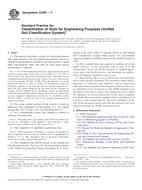
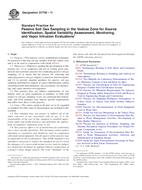 ASTM D7758-11
ASTM D7758-11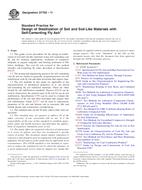 ASTM D7762-11
ASTM D7762-11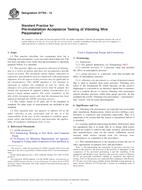 ASTM D7764-12
ASTM D7764-12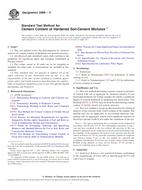 ASTM D806-11
ASTM D806-11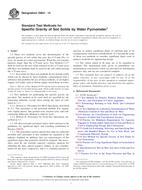 ASTM D854-14
ASTM D854-14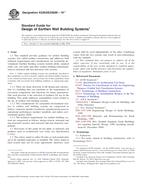 ASTM E2392/E2392M-10..
ASTM E2392/E2392M-10..
 Cookies
Cookies
